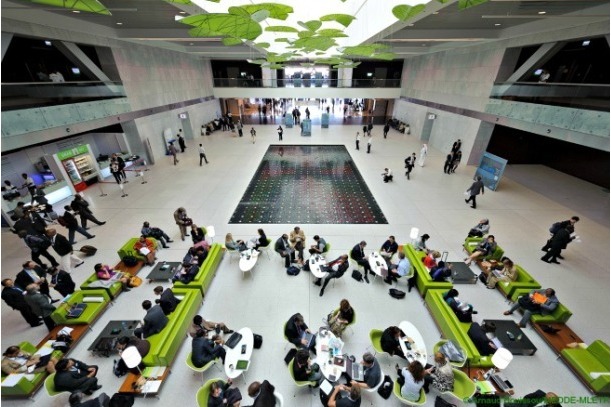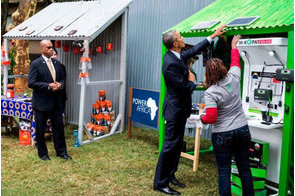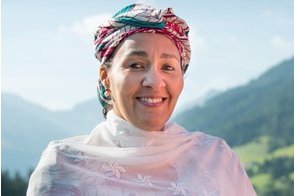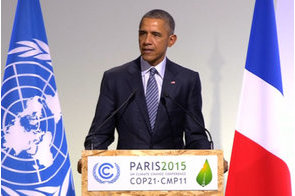Can COP21 save our planet?

Summary
Countries are getting ready for Paris in the hope that agreements will be signed and new mechanisms will be implemented afterwards.
The 21st session of the Conference of the Parties (COP21) to the United Nations Framework Convention on Climate Change (UNFCCC) will be held in Paris, France, from November 30 to December 11, 2015. There are very high expectations that countries of the world who will gather together for COP21 will reach a legally binding agreement on climate change, even as the earth continues to heat up due to anthropogenic greenhouse gas (GHG) emissions into the atmosphere.
Brief history of UNFCCC and COP
To protect the earth from the potentially devastating effects of climate change, the nations of the world came together in Rio de Janeiro back in 1992, to form the United Nations Framework Convention on Climate Change, an international environmental treaty that sets the framework for legally binding limits on greenhouse gas emissions. Particularly, article 4 of this Convention indicates, among other things, that all countries have the common but differentiated responsibilities in protecting the climate and shall consider their specific developmental priorities and circumstances to formulate, implement, publish and regularly update measures to mitigate and facilitate adequate adaptation to climate change.
Since the adoption of the UNFCCC, the COP was initiated as a yearly meeting of all parties or signatories to the convention to sit together, review progress made on the implementation of different decisions taken at various COPs and provide new directions and initiatives.
UNFCCC Mechanisms
Indeed, since the Framework Convention was established, various mechanisms have been put in place to reduce GHG emissions – with more or less success. The following is a non-exhaustive list of mechanisms readily available that directly interest/benefit Africa.
The Clean Development Mechanism: The Clean Development Mechanism (CDM), together with the Joint Implementation (JI), were put in place at the COP3 in 1997 in Kyoto, Japan. The CDM enables developed countries (known in the Kyoto Protocol as Annex I countries) to offset part of their emission reduction commitments through purchase of Certified Emission Reductions (CERs) from clean projects implemented in developing countries (known in the Kyoto Protocol as Non-Annex I countries). To date, there are about 8,000 CDM projects registered around the world. If all of them were to be fully implemented by all the parties, this will result in the reduction of the equivalent of more than 8 billion tons of carbon dioxide by 2020. Unfortunately, Africa has just about 200 of registered CDM projects, far less than 3 per cent of the whole pile.
The Nationally Appropriate Mitigation Action: This mechanism refers to a set of actions that are undertaken by countries to reduce greenhouse gas emissions. NAMA was instituted at COP13 in Bali, Indonesia in 2007. Unlike CDM projects, NAMA programmes can be implemented in developing countries with the technical and financial support of developed countries.
As an emissions reduction mechanism, NAMA is still gaining ground. However, a number of projects are already in the pipeline to help developing countries understand and put in place NAMA frameworks. An example is the ADMIRE programme (www.admireproject.org) put in place by Denmark to support NAMA readiness in developing countries. All vehicles and supporting facilities can be found at www.nama-facility.org and www.mitigationpartnership.net.
Reducing Emissions from Deforestation and Forest Degradation: This mechanism was first discussed during COP11 in Montreal, Quebec, Canada. Although it was initially conceived as a mechanism for “reducing emissions from deforestation in developing countries,” it has since evolved to become Reducing Emissions from Deforestation and Forest Degradation, also known as REDD+, which includes the following elements: (1) reduction of deforestation; (2) reduction of forest degradation; (3) forest conservation; (4) sustainable management of forests and (5) enhancement of forest carbon stocks. The REDD+ concept is very complex but it is progressively gaining ground all across developing countries. The following web-based resources give more information about the concept of REDD+ and facilities available to support developing countries in creating REDD+ projects: www.un-redd.org; www.forestcarbonpartnership.org; www.theredddesk.org etc.
The Green Climate Fund: This mechanism was first introduced at the COP15 in 2009, in Copenhagen, Denmark. The idea behind putting in place the GCF is for developed countries to assist their developing counterparts in climate adaption and mitigation efforts by redistributing funds from the rich countries to developing nations. A target of $100 billion in climate finance was initially set to be provided yearly by developed countries by 2020. So far, the GCF has pooled over $10 billion. However, it is not clear as to how this money will be spent. The GCF board was set up at COP16 in 2010 in Cancun, Mexico and has started working at its headquarters in South Korea, with its 24-member Board. It's expected that the first call for projects will be announced before the end of 2015.
Expectations at the COP21 in Paris
Just like the upcoming 21st session of the Conference of the Parties scheduled to take place in France, there were high expectations ahead of the COP15 that took place in Copenhagen, Denmark, in 2009. It was expected that during that COP, nations of the world will make binding decisions to fight climate change. Nothing of the sort happened. Everything was pushed forward to 2015 for COP21. At Copenhagen and after, 2015 looked too far off to ever arrive. But here we are in 2015 and the big question is: “Will there finally be an agreement to limit emission of anthropogenic greenhouse gases and keep the temperature increase on the earth's surface at an acceptable level?”
Countries are getting ready for Paris in the hope that we will have a good outing where agreements will be signed and new mechanisms will be implemented afterwards. In March 2015, Nigeria set up a nine-man inter-ministerial committee to prepare the country's participation at the COP21 in Paris and follow up after the meeting with decisions that will be taken. The then-Minister of Environment, Mrs. Laurentia Laraba Mallam, during the installation ceremony of the committee insisted that preparing for the COP was good, but it was better to implement decisions after the meeting. She said: “This Conference will present itself as a springboard for Nigeria to interact with multilateral and bilateral organizations to pool financial resources for the implementation of climate change activities.”
Africa at COP21
COP21 is probably the most important COP of this century and all countries will be there fighting for their causes. African countries, hopefully, have learned from previous COPs and the expectation is now that they will have one and the same voice in Paris on important decisions that will be taken and that will bring about maximum benefit to the continent.
Africa needs to fight for itself. Other countries and continents will be busy fighting for their respective interests. The United States, for instance, will be fighting not to have a binding commitment and will continue to try to have their emission reductions reference year at 2005 (while Europe will be pushing the U.S. to go back to 1990 as reference year). China will be defending itself to continue to be considered as a developing country and, therefore, continue to emit GHG without any limit until when it would be considered a developed country (China is expected to become a developed nation by 2030). Brazil will be in Paris trying to get the maximum out of its forest and reforestation activities. Large parts of South East Asia will be trying to convert all their large monoculture oil palm plantations into forestry and claim carbon revenues from it, and so on.
Africa has to be united to defend its position on the following subjects and many others not listed here:
• Mobilisation of international financing for Africa to fight climate change should be in the range of $7-15 billion per year, but that is now just around $1-2 billion per year. African countries should fight to get more commitments. As we have often emphasised in Financial Nigeria, money is not going to solve all our problems. Mobilizing money is in order, but using it wisely and strategically on the continent to boost Africa's green economy would be the approach to take.
• Africa is suffering already from the negative effects of climate change. There are already millions of environmental refugees on the continent – people leaving their homes to find better places because of change in environmental conditions. Africa should put that on the table at COP21 and debate how international technical and financial support will help solve this climate refugee problem.
• Many mechanisms like the CDM, NAMA, REDD+ etc., which were put in place years ago, are not really benefiting Africa because of lack of technical resources and seed-funding to start projects and programmes. This should be fulsomely addressed.
• Emission reductions are normally based on existing emissions. In many cases, however, Africa has not really emitted GHG compared to other regions. It is, therefore, important to see how the continent will benefit from a green growth development strategy rather than comparing emission reductions to a reference year. Many efforts are surely being made at UNFCCC level but it's important Africa continues to fight to get more from these mechanisms.
• The Green Climate Fund Board has been installed already and has started operating. The Fund has more than $10 billion available to spend on projects, but it's not yet clear how the money will be spent, what type of projects will be selected, how private enterprises will apply (private sector is very important for sustainable development in Africa) etc. It's important Africa understands the concept of the GCF and influence the way it will be managed to make sure the continent will get the maximum benefit out of it, unlike the CDM where to date, Africa has less than 3 per cent of the total projects.
A lot of discussions are ongoing among African leaders and groups, and the hope is that they will find a common ground to negotiate in Paris and come back home with the best solutions for its people and take the continent to the next level of green economic development.
Durando Ndongsok, a Financial Nigeria Columnist, is Managing Director of the Cameroon based S2 Services Ltd. S2 Services promotes business approach to sustainable development with the belief that this is the best approach to develop Africa as philanthropy has shown its limits. Durando has been working for several years in the CDM industry. Email: d.ndongsok@s2-gmbh.com; URL: www.s2-gmbh.com
Related
-
Power Africa launches new initiatives at COP21 in Paris
Scaling up access to cleaner electricity helps mitigate climate change and enhances resilience to climate shocks.
-
Multilateral treaty bans illegal timber export from Nigeria
EIA estimates more than four million trees worth roughly half a billion dollars were cut down in Nigeria from January 2017 ...
-
Friends of the Earth says United States undermines ambitious and just climate deal
...says the Paris Climate Agreement is not a fair, just or science-based deal.







